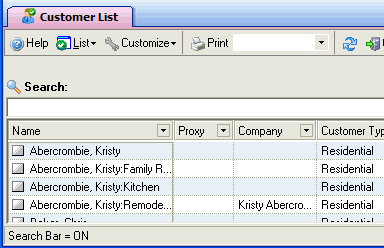Other Resources
The lists in All Orders are the jumping point to all the records in All Orders. For example, if you are looking for customer you would start off with the customer list. The icons on the Home screen or toolbar that have a small check box are lists.
 Click this icon to open the Item List
Click this icon to open the Item List
You can also get to all the lists from the List menu. In All Orders there are two types of lists; table style lists and profile lists. The table style lists are used for the primary entities like item, customer and vendor and are contained on the top portion of the List menu. Table style lists are also used for all the transaction type like sales order and purchase orders. On the bottom part of the List menu you will see the profile lists. The profile lists are entities that are set up occasionally and are used in the primary entities and transactions for example Item Group and Sales Rep.
In addition to the four main entities (Items, Customers, Vendors, and Locations), All Orders also maintains lists specific to Sales, Purchasing, Production, and Warehousing. Finally, Profile Lists are tables of secondary data that provide supplemental information to support your lists and transactions.
Viewing a list is simple. Simply select the desired list from the Lists menu. Additionally, area-specific lists (e.g. all lists that are pertinent to Sales) can be found in the menu for that area.
The table style list all work in the same way. Finding
information in a particular field is quick and straightforward. Above
each list, you will find a special search bar. Simply click the bar just
above the field you wish to search on, and start typing. All Orders will
take you to the first matching record for the string you've entered:

To open a record, just double-click it. You'll be taken to the appropriate
form with the record's fields already filled in. These can be altered
at will. For the four main entities, you'll also see a special Info
icon for each record that looks like this: 
Double click this icon to view a comprehensive Info Screen, which comprises a complete history for the record in question. On the Customer Info screen, for example, you'll be able to see every sales order the Customer has ever placed. Every quote they were given. Every return they made. It's a handy place where all information even remotely related to that record is available in one handy place.
Records can be sorted according to a column by clicking on that column. Clicking the same column a second time will display the records in descending order. Hold down the shift key as you are clicking column headers to sort on more than one column at a time.
You can set a filter on a particular field by clicking the small arrow
( ) on the right-hand side of one of your columns. For example,
when filtering by Item Group, I can choose any of the following:
) on the right-hand side of one of your columns. For example,
when filtering by Item Group, I can choose any of the following:

It allows to filter out blank fields (or filter to view only blank fields). Additionally, a comprehensive list of current field values is displayed. In the example above, if I were to select PT, then only those Items with the Item Group "PT" (Part) would show up in the list.
Notice that you also have a Filter For text field at the bottom. This is handy for selecting multiple values, and is particularly handy filtering numerical fields, as Boolean symbols are accepted (<, >, =, <>, etc.). Note that you can also use the wildcard (*) character to help target your searches. For example, if you're trying to recall a Customer, and you know his first name is John. You can enter "*john" to bring up all Johns in your Customer list. Any set filters can be cleared by choosing Clear Filter from the current tab's List drop-down menu, or by choosing (All) from the Filter menu. If you don't clear the filter, then the filter will be saved when you close the list. You can see what filters are in place at the bottom of the application window, just above the status bar:

An easy way to clear all filters (other than the default one) is to simply click the X to the left of the filter line.
Keep in mind that each list has its own toolbar to help you manipulate
your list information, change the aesthetics, and execute other tasks.

This is what you can expect to find on the tab of every List:
Help. Opens the help file you're currently reading.
List. This menu allows you to customize your view by selecting the fields you want to be viewable in the current list. Additionally, you can select records, delete them, choose between a flat and hierarchical view of your data, and add the record to a document.
Customize. This drop-down menu enables you to make aesthetic changes to the view of the current list. You can do things like change the font, set alternating row colors, turn the Search Bar on or off, and specify whether you'd like the list contents to fit on one screen.
Print. Allows you to make a printout of your records. You can choose between the entire list and selected records only by making the appropriate choice in the accompanying drop-down list. In addition, you can automatically print specific List-related reports by choosing the desired report from the drop-list that appears next to the Print button.
Refresh. Reloads the current list. A List will automatically refresh when data is changed on another screen that affects the List. You may turn off auto-refresh in Preferences.
Close. Closes the current list.